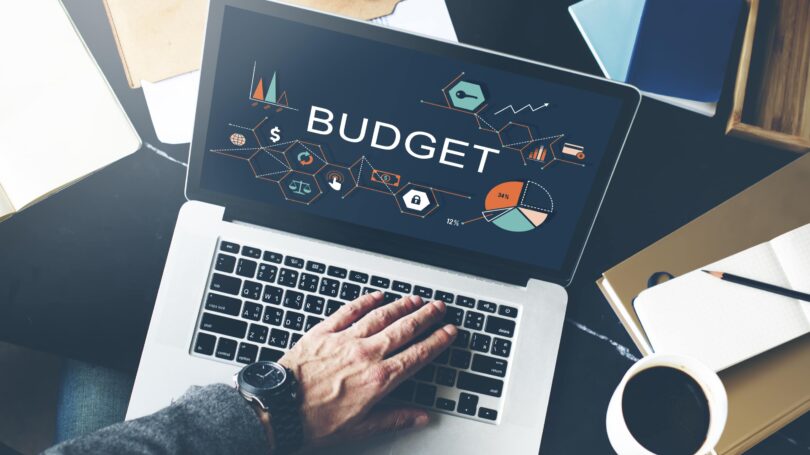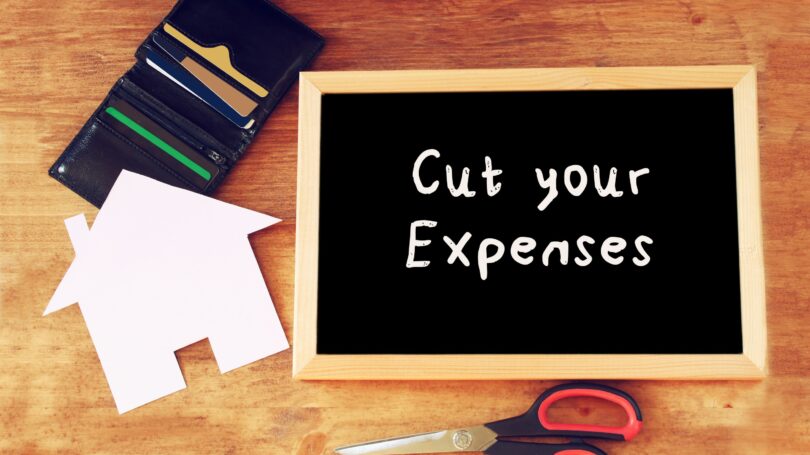According to a 2017 CareerBuilder survey, 78% of all workers say they live paycheck to paycheck. It’s not just low-wage workers who have this problem, either. Nearly 1 out of 10 workers making $100,000 or more say they always or usually live paycheck to paycheck, and 59% of them are in debt.
Living paycheck to paycheck is like being stuck in a hamster wheel; no matter how fast you run, you can never get ahead. Every penny you make goes toward paying the bills, and a major unexpected expense can completely derail your budget, sending you scrambling for the credit cards and driving you deeper into debt. There’s no money left at the end of the month to put toward long-term financial goals like buying a house or saving for college, let alone for luxuries like a nice vacation.
The good news is that there are ways to break out of the paycheck-to-paycheck cycle. With effort, you can trim your expenses and boost your income to create more wiggle room in your budget. Over time, you’ll be able to save money for your long-term needs and build an emergency fund so you’ll no longer have to fall back on credit in a crisis.
Here’s how to get started.
1. Track Your Spending

The first step to taking control of your finances is to figure out exactly where all your money is going. Many families don’t realize they already have more than enough to cover their bills because their extra cash gets frittered away throughout the month. Your goal is to track down those hidden budget busters and eliminate them.
So, for the next month, keep track of every single penny you spend, from your monthly rent payment to that dollar for a cup of coffee. Jot down your expenses in a notebook or use personal finance software like Mint to keep track of your spending.
Make your list as detailed as possible. Instead of just writing, “Groceries: $60,” keep the receipt so you can see exactly what you bought and what it cost. This will help you later when you’re looking for expenses to cut. Make sure to include hidden expenses too, like bank fees or the interest you pay on credit card debt.
Simply seeing all your expenses written down in black and white can be a revelation. For instance, you might realize you’ve been blowing nearly $30 a month on ATM fees or $50 a month grabbing a snack at the convenience store on your way home from work. Seeing how much these nickel-and-dime expenses are costing you could be enough to shock you into changing your habits, freeing up cash in your budget at the end of each month.
However, if you look at your expense list at the end of the month and still feel like you have no idea how to save, don’t worry; your effort hasn’t been wasted. It will help you move on to the next step: serious budgeting.
2. Make a Budget

Once you have all your monthly expenses laid out, use that information to make a budget. Group your expenses into categories – such as food, utilities, and entertainment – and note how much you spend on each one. You can do this on paper, use a spreadsheet program like Microsoft Excel, or use dedicated budgeting software like Personal Capital or You Need a Budget (YNAB).
Keep in mind that the costs you wrote down for the past month don’t necessarily reflect your spending for the entire year. You probably have recurring expenses that don’t come due every month, like quarterly property taxes or your annual auto registration. To fit these expenses into your budget, add up how much they cost you every year, then divide that number by 12 and add a line for it to your monthly budget. That’s the amount you should set aside each month to cover these costs when they arise.
You could also have expenses that vary from month to month, such as your utility bill. If your bill this past month was lower than average, setting aside that same amount for utilities every month won’t be enough. To deal with these fluctuating expenses, look back at your bills for the past year and add them up. Divide this total by 12 to get the average amount you’ll need for this expense in a given month and enter that in your budget.
Once you’ve figured out all your monthly expenses, subtract the total from your monthly income and enter the result on a new line under “Savings.” This is the amount you’ll be setting aside each month for your future goals. Of course, if you’ve been living paycheck to paycheck, there’s a good chance this amount is currently zero or even negative. Don’t worry; you’ll fix that in the next step.
3. Cut Expenses

To make room in your budget for savings, you need to look for other things you can cut. There are two main types of expenses in your budget: fixed and flexible. Fixed expenses are things that cost the same every month, such as your rent or car payment. Flexible expenses are those that vary from month to month, such as gas and groceries.
To save as much as possible, you need to look at both types of expenses. Flexible expenses are usually easier to cut since they don’t require major lifestyle changes. However, you can often find greater savings by cutting back on fixed expenses since these are some of the biggest items in your budget.
Trim the Fat
Examine your flexible expenses and look for unnecessary extras you could cut. Consider every single purchase you make, from a new suit to a pack of gum, and ask yourself: Did I really need that? If so, could I have bought it for less?
The first expenses you should consider cutting back on are luxuries, like dining out or entertainment. For instance, if you currently eat out three times a week, you could cut it down to one while also looking for ways to eat out for less. Similarly, you can trim your entertainment budget by finding cheaper concert tickets or renting movies instead of going to the theater. Other ways to stop sneaky budget busters include:
- Looking for a cheaper cell phone plan through a provider like Mint Mobile.
- Finding cheaper alternatives to cable TV, such as streaming services or using Sling TV.
- Canceling your gym membership and finding cheaper ways to exercise
- Cutting back on costly habits like alcohol, coffee shop visits, and playing the lottery
As you identify expenses to cut, adjust your budget to account for them. Take all the money you’re cutting out of categories like food or entertainment and add it to the savings line. It’s motivating to see how much money you’ll be adding to your savings every month.
However, don’t make the mistake of trying to take these categories all the way down to zero so you can save as much as possible. One of the main reasons budgets fail is that they’re too restrictive. Make sure to allow yourself some cheap luxuries to combat frugal fatigue.
You can also sign up for Trim which will look for subscriptions you could live without. They will also negotiate lower rates on cable and internet bills.
Tackle the Big Stuff
If the savings line in your budget still looks pitifully small after you’ve cut all the luxuries you could find, perhaps your problem is that you’re spending too much on necessities. Cutting back on these expenses is more painful but offers the potential for big savings. Hone in on the largest lines in your budget; the more you’re spending now, the more it’s possible to save.
Here are some ways to cut the biggest expenses in your budget:
- Housing. Experts usually recommend keeping your monthly housing cost down to 30% of your gross pay. If yours is higher than that, maybe it’s time to look for an apartment that’s more affordable. If you’re a homeowner, see if you can refinance your mortgage to lower the monthly payment.
- Transportation. If you can give up your car and switch to some combination of walking, biking, ride sharing, and mass transit, you could save thousands of dollars each year. If that’s not an option, consider trading in your car for a cheaper model or doing some of your own auto maintenance. If you normally rely on public transportation, see if you can cut that cost by using a monthly pass or traveling at off-peak hours.
- Child Care. For parents, child care is one of the biggest expenses in the budget. Ways to save on this include shopping around for a cheaper day care facility or adjusting your work schedule so you can look after your kids at home outside of school hours. Care.com is a great resource when looking for different child care options.
- Health Care. Health insurance can be expensive, but going without it is definitely the wrong way to save on health care. It leaves you vulnerable to a catastrophic medical bill, which would be even more expensive. Instead, see if you can lower your health care premium by switching plans, raising your deductible and taking out a health savings account through Lively, or taking advantage of subsidies from Obamacare. You can also reduce your need for care by adopting healthy habits and practicing preventive medicine, such as seeing a doctor for small problems before they turn into big ones.
- Groceries. There are dozens of ways to slash your grocery bill. One of the best is to cook from scratch rather than relying on prepared foods, which are some of the priciest items you can put in your cart. Replace meat-heavy meals with vegetarian dishes and switch from bottled water to tap water. You can also save by switching from name brands to store brands, using a price book to find the cheapest stores, stocking up during sales, using coupons or Ibotta, and buying in bulk.
- Utilities. You’ve probably already heard about simple ways to lower your utility bills, such as turning down the thermostat in winter, switching to energy-saving lightbulbs, or washing only full loads of clothes and dishes. If you’ve already taken all of these steps, look for bigger ones, like cooling off without air conditioning in summer, doing a home energy audit, or ditching your landline phone.
- Insurance. Just like health insurance, auto insurance is an expense you shouldn’t try to do without. However, you can save on auto insurance by shopping around for a cheaper policy (try Liberty Mutual or Allstate), raising your deductible, or dropping extras you don’t need. The same strategies can help you save on homeowners insurance too.
Pro tip: When shopping for a lower homeowner’s insurance policy, use a company like PolicyGenius. They will provide you with multiple quotes so you know you’re getting the best rates possible.
4. Boost Your Income

For most people, cutting expenses is the easiest way to boost savings. However, if you’re already living on a shoestring budget, there’s probably not much for you to cut. In this case, the best way to save more money is to make more money. There are two main ways to do this: earn more at your job or find ways to bring in income on the side.
Earn More at Work
At first glance, it may not be obvious how you can increase the income you get from your job. After all, your boss sets your pay rate, not you. However, if you look carefully, you’ll find there are actually several ways to give your paycheck a little boost. For instance, you can:
- Adjust Your Taxes. If you’re used to getting a big refund check after filing your taxes every year, that’s a sign you’re having too much tax taken out of your paycheck. You can instantly increase the size of your paycheck by adjusting your tax withholding. To do this, go to your payroll office and ask to fill out a new W-4 form. You can use the IRS W-4 worksheet or IRS Withholding Calculator to figure out how much tax you should be withholding.
- Work More Hours. If you work at a job that pays by the hour, you can increase your pay by putting in more hours. Try asking your boss if you can work an extra shift here and there or put in more overtime. Overtime hours are especially helpful since your boss has to pay you time-and-a-half for them – that is, one and a half times your regular pay rate.
- Ask for a Raise. If you feel like you’re not making enough money at your job, maybe it’s time to ask for a pay raise. Start by doing some research to figure out what people in your position usually earn. The salary calculator from Educate to Career is a good resource for this. Then, figure out the right time to ask – for instance, after your yearly performance review. Put together a list of your best arguments for why you’re worth more money and practice them before you walk into the boss’s office.
- Apply for a Promotion. If you can’t earn more in your current position, perhaps you can earn a promotion. Figure out what specific position you’d like to set your sights on, then start brushing up on the skills you’ll need to qualify for it. However, don’t focus so much on the job you want that you neglect your current one. You need to prove you’re an asset to the company before the boss will entrust you with new responsibilities.
- Find a Better-Paying Job. If you just can’t squeeze any extra money out of your current job, try looking for a new one with better pay. However, when considering a potential new job, don’t look only at the salary. Many financially successful people say the real secret to their success was working at a job they loved where they were always happy to put in the hours. Take your time researching new positions and look for one that can make both you and your bank account happy.
Find Sources of Side Income
If you can’t find a way to earn more at your main job, don’t lose hope. There are many ways to make extra money on the side, such as:
- A Second Job. One way to bring in extra income is to take on a second job. Maintaining two jobs at once is demanding, but if you can manage it for even a short time, it can give you the extra cash you need to get your emergency fund started. If you currently have a 9-to-5 job, look for one you can do in evenings or on weekends. If you need a more flexible schedule, consider DoorDash or driving for Uber or Lyft, which allows you to set your own hours.
- A Side Business. Instead of getting a second job working for someone else, you can start a side business and be your own boss. Possible side businesses include babysitting, tutoring, dog walking, and freelance writing. If you’re an artist or a crafter, you can earn extra cash selling your wares on Etsy. You can also pick up odd jobs on Fiverr or TaskRabbit.
- Renting Out a Room (or Something Else). One way to bring in a steady stream of extra cash is to rent out a room in your house if you have one to spare. If you don’t want to take on a regular tenant, you can rent your spare room to occasional guests through a service like Airbnb. Rooms aren’t the only thing you can rent out, either. You can rent out your unused parking space through a service called SPOT or rent anything from your car to your wedding dress through Zilok.
- Selling Your Stuff. Have you ever spent money on something you don’t use anymore, like clothes that no longer fit or a stamp collection you’ve lost interest in? Instead of feeling bad about it, turn those unused items into cash. Antique dealers could be interested in your old furniture, jewelry, or coins. You can sell clothing, furniture, and other items in good condition at consignment shops. For everything else, there’s eBay.
- Cashing in Rewards. If you subscribe to any shopping rewards programs and apps, cash in your rewards regularly and feed the money into your new savings account. If you don’t, perhaps this would be a good time to join one. Programs with cash rewards include Survey Junkie, Inbox Dollars, Swagbucks, and Ibotta.
5. Jump-Start Your Savings

Once you’ve found ways to set aside more money in your budget for savings, you need to start putting that money to work for you. If you simply leave it sitting in your checking account, it won’t earn much interest, and you’ll have to fight off the temptation to dip into it.
To avoid this problem, set up an automatic savings plan. Take the money you’ve earmarked in your budget for savings and automatically transfer that sum out of your account each month and into a separate savings account. Alternatively, you can arrange to have your entire paycheck directly deposited to your savings account on payday and then set up an automatic withdrawal of the amount you’ll need to cover your monthly expenses.
The best place to stash your growing savings is an interest-earning account at a separate bank. That way, you won’t be able to withdraw those funds as easily, so you won’t be tempted to use them for anything short of a real emergency. An online bank account at CIT Bank is a good choice since it will earn a higher interest rate than a basic savings account. Other low-risk investments for your emergency savings include money market accounts and CDs.
You can give your savings an extra boost by banking financial windfalls. For instance, if you get a bonus at work or a refund on your taxes, don’t automatically spend it; tuck the money, or at least part of it, into your new emergency fund.
Similarly, whenever you get a raise, make sure to readjust your budget so part of that extra money goes into savings. It’s okay to use some of the cash infusion to pad your budget a bit and treat yourself to a few extra luxuries, but don’t spend it all. If you’ve been getting along on a budget of $3,000 a month until now, you can continue to get along on that amount or just a little bit more, sending the bulk of your raise into savings and investments.
Pro tip: Digit is a great tool to help you save money automatically. They will analyze your spending and automatically save the perfect amount.
6. Stay on Target

At this point, you’ve gotten control of your spending, made a budget with room for savings, and started building wealth for the future. However, simply putting a budget down on paper isn’t the same thing as sticking to it over the long term. If you lose focus, it can be all too easy to slip back into your old habits and end up living paycheck to paycheck once more.
The key to keeping yourself on track is to focus on your goals. It’s much easier to stay motivated to save when you know exactly what you’re saving for. For example, maybe you’re hoping to save enough to put a down payment on a house, travel around the world, enjoy a comfortable retirement, or even achieve financial independence early.
Whatever you’re aiming for, write down your goal or find an image that brings it to mind and put it someplace where you’ll see it every day. This will keep your goal firmly in sight and make it easier to stick to your new budget.
If you’re still concerned you won’t have the willpower to stick to your new habits, it could help to have someone to hold you accountable. Share your new financial plan with a family member, close friend, or financial advisor and ask them to help hold you to it. Meet with them on a regular basis to let them know how you’re doing with your new plan. They can cheer your successes and encourage you to get back on track if you slip up.
What Not to Do
There’s no way around it: making and sticking to a financial plan is a lot of work. It can be tempting to take the easy way out by simply borrowing money whenever you run short.
Unfortunately, that’s not a real solution. In fact, in the long run, it will make your problems worse by loading you down with debt you have to pay interest on. This will further eat into your available funds every month, sending you back for yet another loan, and on and on in an endless downward spiral.
To avoid getting caught in this trap, you must avoid relying on debt for your everyday expenses. This includes:
- Credit Cards. It’s OK to continue using credit cards as a convenient way to pay for purchases, so long as you pay them off in full at the end of every month. However, if you don’t have the discipline to do that – or if you can’t control your spending when you pull out the plastic – then stop carrying credit cards. Don’t cancel the accounts, since doing this will hurt your credit score, but don’t use the cards. Pay for all your purchases with cash or a debit card, which won’t allow you to spend more than you have in the bank.
- Auto Loans. If at all possible, avoid taking out a loan to buy a new car. If there’s no way to keep your old car running, then replace it with a used car you can afford to buy with cash. Don’t worry; if you stick to your financial plan, in time, you’ll build up enough savings to buy a new car without having to finance it.
- Loans From Family or Friends. Debt is always financially costly, but loans from friends or family members can be emotionally costly as well. It’s embarrassing having to ask other people to bail you out of financial difficulties, and if you do it repeatedly, they could come to see you as a burden. Even if they’re willing to help you out, it will put a strain on your relationship as long as the money remains unpaid.
- Payday Loans. Any kind of debt is a drain on your finances, but payday loans are the worst of all. These small, short-term loans have ludicrously high interest rates – close to 400% on an annual basis – and come due all at once, rather than being paid back in installments. This makes it hard for borrowers to pay them back on time, so they often end up renewing the loan and making that same hefty interest payment several times in a row. Avoid this type of loan at all costs.
Final Word
Escaping the paycheck-to-paycheck lifestyle takes time and patience. It’s kind of like trying to eat healthy if you’re used to a diet of junk food; you shouldn’t expect to change your habits overnight. Don’t be too hard on yourself if you slip up, but don’t take it as a reason to give up completely, either.
Instead, remind yourself again of what you’re working for. Think about how much less stressful your life will be when you know there’s money in the bank to cover any kind of unexpected expense. Focus on all the things you’ll be able to do with your savings, like paying off old debts or buying a new car.
Keep your eyes on the prize, then get right back on that horse and keep riding. You can do it!
Do you live paycheck to paycheck? What strategies are you using to get out of this cycle?